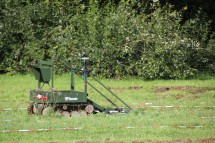U.S. Army to Develop Smart Mine Detection System
The AMDS program is developing a prototypeUGV-based mine-detection sensor suite that can find buried anti-personnel mines. The AMDS consists of a suite of three payload modules to be deployed on a remotely operated man transportable robotic system (MTRS).
According to the Military & Aerospace, the three mine-detection sensors involved in the AMDS project are the mine detection and marking payload module, the explosive hazards detection and marking payload module, and the neutralization payload module.
The mine detection and marking payload module remotely detects and marks surface-laid and buried metallic and low-metallic antitank and antipersonnel land mines and scattered munitions.
The explosive hazards detection and marking payload module remotely detects and marks surface laid, partially buried, and camouflaged explosive hazards. The neutralization payload module, meanwhile, remotely neutralizes surface laid, buried and camouflaged explosive hazards.
In recent years, L-3 CyTerra in Orlando, US and NIITEK in Dulles, Va., have developed complementary senor suites using ground-penetrating radar and electromagnetic induction sensors. Applied Research Associates Inc. (ARA) in Albuquerque has also been involved in AMDS sensor development. The AMDS program is also working with industry and academia to develop automatic target recognition (ATR) algorithms.
The AMDS prototypes are to be mounted to a government-furnished TALON IV tracked UGV from QinetiQ North America in Reston, Va.




